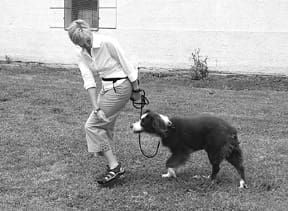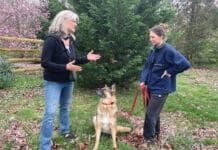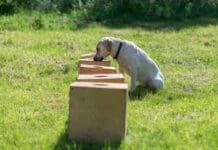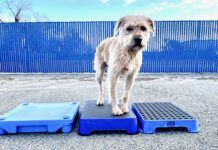Walking politely at your side doesn’t seem like it should be so difficult to teach a dog, but it often proves to be the most challenging behavior for dog owners to achieve. Dogs who are letter-perfect with their sits and downs, targeting, and “leave it” exercises in the training center happily drag their owners across the parking lot to and from their cars before and after class.
Why do so many dogs pull on leash? Because they can. Many dogs learn, from the time they’re wee pups, that pulling on the leash gets them where they want to go. They pull, owner follows. There are a number of other reasons that dogs pull:
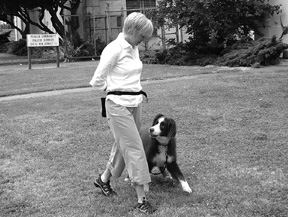
• We are slow and boring, and the world is infinitely exciting and rewarding. If you take your dog for a hike in a safe place off leash, chances are good he’ll run several miles for every mile you trudge on your pathetic two human legs.
• It’s not a natural behavior. Rarely do dogs plod sedately side by side. They dash, dart, gallop, romp, run, and trot, but rarely do they plod, unless you have a senior citizen who’s feeling his years.
• Lack of consistency. Although they may understand the concept of polite leash training and would like their dogs to be a pleasure to walk, most owners are also eager to get where they’re going, sometimes. If you insist on a loose leash most of the time, but allow him to pull when you’re in a hurry or your attention is elsewhere, pulling is likely to be his first behavior choice when he really wants to get somewhere.
• Behaviors that are intermittently reinforced are very durable. If a dog has learned to pull and is occasionally rewarded for this (by getting to reach what he is pulling toward), he will continue to pull whenever the opportunity arises.
• Sometimes the dog pulls because the owner never gives him slack in the leash. Many owners suffer from “Floating Arm Syndrome” – no matter how many times you remind the owner to keep her arm at her side in order to keep slack in the leash, that arm mysteriously levitates to shoulder height, and the leash tightens, even when the dog is walking politely by her side.
• If I attach a rope to your belt and pull, you’re likely to pull back. If I push, there’s a good chance you’ll push back. This is the “opposition reflex,” a natural response that enables us to maintain equilibrium and stay upright. Dogs have it too, and it kicks in when the leash tightens on their collar – they pull against it.
• It’s not important enough. Some owners rarely put a leash on their dogs because they rarely take them anywhere. For these owners, it’s just not a high priority behavior to practice – so they don’t.
Perhaps it was my early “old-fashioned” obedience training, but I have a real aversion to a tight leash – I find it very annoying to have my dog yanking my shoulder out of the socket. Even though I live on a farm, where dogs don’t often have to be leashed, it’s worth it to me to practice.
Polite walking versus “heel”
Old-fashioned training classes assumed that everyone aspired to the level of precision required for obedience ring competition. We taught students to bark the “Heel!” command and stride forward, using leash “pops” or “corrections” – both euphemisms for punishing the dog with a sharp jerk on the choke collar if he dared stray an inch out of perfect heel position.
You can still find similar old-fashioned training classes today, but increasingly you’ll encounter pet dog training classes, where a cheerful “Let’s Walk!” cue replaces the “Heel!” command, and clicks and treats for reasonably polite walking replace physical punishment for minor missteps.
“Heel” means “walk precisely beside me.” However, a growing number of positive trainers are earning obedience and rally titles for their dogs with enviably high scores by teaching their dogs to walk precisely by their sides without ever jerking on a collar. Rather, sits, heel position, and other required exercises are all taught by shaping, clicking, and positive reinforcement – treats, play, and praise, with the trainer gradually fading the use of clicks and treats before setting foot into the show ring.
Whether your goal is winning trophies and titles in competition or strolling around the block in harmony with your canine pal, you can use the following dog-friendly training techniques and avoid potentially spine-damaging yanks on your dog’s collar. It’s best to practice in short sessions – perhaps 5 to 15 minutes apiece, and to quit while you’re ahead – when you’re having some success and you and your dog are both enjoying the training game.
Free walking
Start with your dog off leash in a safely enclosed area, indoors or out. Yes, you can teach your dog to walk on leash by working without a leash! Have a good supply of tasty treats, and your clicker or other reward marker handy.
Start walking around the enclosed area. Any time your dog is within three feet of you, click! (or use another reward marker, such as the word “Yes!”) and give your dog a treat. Your dog will discover that it’s very rewarding to stay near you and begin to walk with you, at least some of the time. Use a high rate of reinforcement – lots of clicks and treats – accompanied by cheerful praise, to convince your dog you’re more fun and rewarding than the world around him.
When your dog starts to “hang” with you as you walk, pick which side you want him to walk on and start clicking only if he’s on that side. At first, click and treat whenever he’s closer to your chosen side. As he begins to spend more time on that side, click and treat for positions that come closer and closer to your goal walking position. This is called “shaping” – breaking a desired behavior into small steps and reinforcing approximations of the final behavior, gradually tightening the criteria until you eventually have the final goal behavior.
You can use other reinforcers besides food. Pairing your click! and treat with cheerful praise will give your dog a positive association with voice rewards, and help you eventually fade (get rid of) the need for the click and treat. You can also use toys and play as rewards. Hide a small squeaky toy or tug rope in your pocket, and after a stretch of exceptionally nice walking, whip it out, squeak and toss, or play a bit of tug as your dog’s reward. Keep him guessing!
Choosing one side for polite walking will keep your dog from crossing back and forth in front of you and tripping you up. Traditionally, dogs are taught to walk on the left side – possibly a carryover from the time when owners routinely carried and used rifles in their right hands while hunting with their dogs. While some dog sports still hold with this tradition, notably obedience and rally, others, such as agility and canine freestyle (dancing with your dog), ask the dog to work on both sides. Choose the side that works for you and your training goals, and later you can train to the second side as well, if you desire.
When your dog is frequently walking by your side, it’s time to add the leash.
Leash walking
You can start with the leash attached and skip the free walking exercise if you want, but practicing off leash first helps you avoid falling victim to many of the reasons dogs pull on leash. Neither you nor your dog can pull on the leash if it’s not there!
Remember that your dog’s leash is not a steering wheel or handle. It’s a safety belt, intended to prevent your dog from leaving. It’s not to be used to pull him around. To position him by your side to begin walking, rather than dragging him there, use treats and body language to show him where you want him to be.
For left-side walking, start with your dog sitting by your left side. I suggest holding leash and clicker in your left hand (same side as the dog) and having a good supply of treats in your right hand. Make sure there’s enough slack in the leash so it stays loose when your dog is in the reinforcement zone you’ve identified for polite walking. You can also use a waist-belt or otherwise attach your dog’s leash to your body, as long as he’s not big enough to knock you down and drag you.
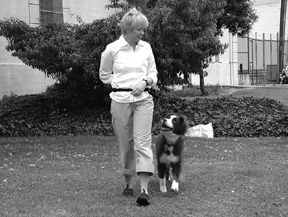
Use your “Let’s walk!” cue in a cheerful tone of voice and start walking forward. The instant your dog begins to move forward with you, click! and treat. At first, click! and treat very rapidly – almost every step. When your dog is attentively focused on his new, generous, treat-dispensing machine (you!), you can gradually reduce the rate of reinforcement.
Careful! If you reduce the rate too quickly or too predictably, you’ll lose the behavior. As you gradually reduce the rate of reinforcement, be sure to click! and treat randomly – so your dog never knows for sure when the next one’s coming. If he knows you’re going to reinforce every tenth step, he can quit paying attention for nine steps, and zero back in on you on the tenth. This phenomenon is called an interval scallop. We humans are creatures of habit, and easily fall into predictable patterns. Our dogs are masters at identifying patterns.
The manner in which you hold and deliver your treats is critical to success with polite walking. When you walk, have the treats in your right hand but hidden behind your right hip. If you hold them in your left hand where your dog can see or smell them, it will be harder to fade treats later on. If you hold them in front of you in your right hand, your dog will keep stepping in front of you to watch your hand (treats), and you’ll keep stepping on him.
To deliver treats, wait for a second or two after the click! as you keep walking, then bring your right hand across the front of your body and feed the treat just behind your left knee. Quickly move your hand behind your right hip as soon as you’ve delivered the treat. Feeding the treat where you want your dog to be – on your left side – reinforces that position. If you feed the treat in front of you, you’ll reinforce that position, and you’ll be stepping on him again.
Remember to click!, then treat after a brief pause. If you begin to move your treat hand toward him before the click!, he’s just thinking about food rather than what he did to make you click the clicker. For the same reason, you want to lure as little as possible during leash walking. Luring will keep him in position, but it interferes with his ability to think. Your goal is to get him to realize that walking in the desired reinforcement zone makes you click! the clicker and earns him a reward.
If your goal is a show-ring heel, continue to shape for a more precise position as previously described, until your dog will walk reliably with his shoulder in line with your leg. Then change your cue from “Let’s Walk!” to “Heel!” so your dog can distinguish between “now we’re going for a relaxed stroll,” and “now we’re working for that perfect 200-point score.”
The lure of the lure
Of course, it’s not always that simple. There will be times when your dog forges ahead of you and tightens the leash, or stops to sniff something of interest as you walk past him. There are positive solutions for those challenges as well.
When you have to pass a very tempting distraction, use a lure, briefly, to get your dog past the distraction. Put a tasty treat at the end of his nose (the more tempting the distraction, the higher-value the treat must be) and walk him past. As his polite walking behavior improves, your need for luring should diminish.
About face
Direction changes can be very useful in teaching polite leash walking. When your dog starts to move out in front of you, before he gets to the end of his leash, turn around and walk in the opposite direction.
Do this gently; you don’t want him to hit the end of the leash with a jerk if he doesn’t turn with you! As you turn, use a cheerful tone and a kissing noise to let him know you’ve changed direction. When he notices and turns to come with you, click! and offer a treat behind your left knee. He’s now behind you, so you’ll have ample opportunity to click! and treat while he’s in the zone as he catches up to you.
Be a tree
There will be times when your dog pulls ahead of you on a tight leash. This is a great opportunity to play “Be a tree.” When the leash tightens, stop walking. Just stand still – like a tree – and wait. No cues or verbal corrections to your dog. Be sure to hug your leash arm to your side so he can’t pull you forward.
Eventually, he’ll wonder why his forward progress has stopped, and look back at you to see why you’re not coming. When he does, the leash will slacken. In that instant, click! and feed him a treat behind your left knee. The click! marks the loose leash behavior, and he’ll have to return to the reinforcement zone to get it. Then move forward again, using a higher rate of reinforcement if necessary, until he’s again walking politely with you.
Penalty yards
If “Be a tree” is not working, add “penalty yards.” Your dog usually pulls to get somewhere – or to get to something. If he won’t look back at you when you make like a tree, back up slowly – with gentle pressure on the leash, no jerking, so he’s moving farther away from his goal. This is negative punishment – his pulling on leash behavior makes the good thing go farther away. When the leash slackens, click! and treat, or simply resume progress toward the good thing as his reward.
Go sniff!
Sniffing is a natural, normal dog behavior. If you never let your dog sniff, you’re thwarting this hard-wired behavior. He may become frustrated and aroused if he’s constantly thwarted, so when you’re doing polite walking together, you can sometimes give him permission to sniff.
If he stops to sniff keep walking, putting gentle pressure on his leash to bring him with you, giving him a click! and treat as soon as he moves forward. When you know you’re approaching a good sniffing spot, however, you can give him permission by saying “Go sniff!” Give him enough leash to reach the spot without pulling, even running forward with him if necessary. You can also use “Go sniff” as a reinforcer for a stretch of nice leash walking!
Proofing
Proofing is the process of solidifying polite leash-walking behavior in the presence of distractions. This works best with controlled distractions, starting at a distance where the temptation is not strong enough to compel your dog to investigate.
Practice his leash-walking behavior at a distance that works, then gradually bring the distraction closer. Increase the rate of reinforcement or the value of the reinforcer as needed, but try to avoid bringing the distractor so close you have to use a lure to get your dog past it. As you practice with various temptations at closer distances, your dog will learn to keep working with you and you’ll be able to reduce the rate of reinforcement again.
It’s up to you to decide whether you want your dog to walk politely on leash or heel precisely at your side. Dogs want good stuff, and they do what works to make it happen. If walking on a loose leash makes good stuff happen for your dog, the two of you will stroll happily side-by-side into the future together.


